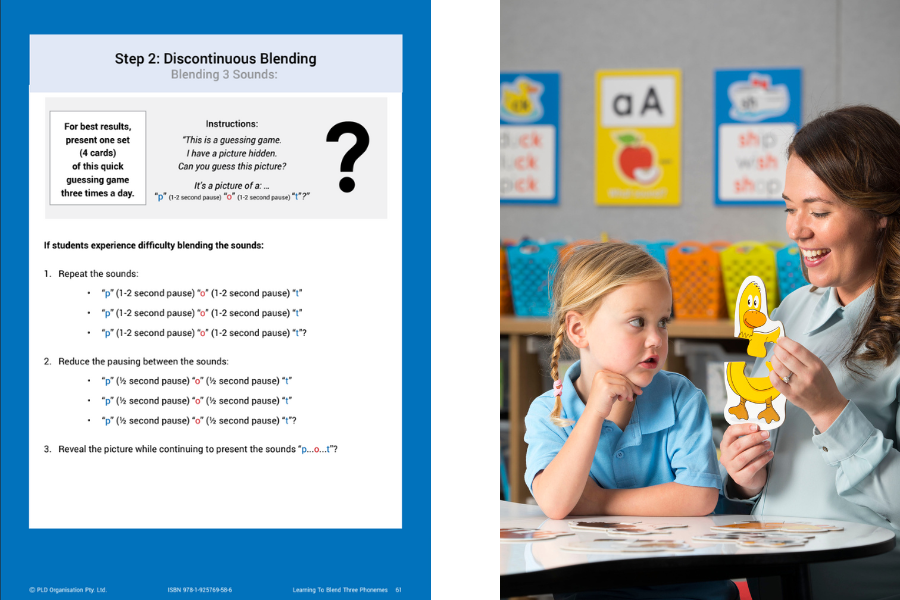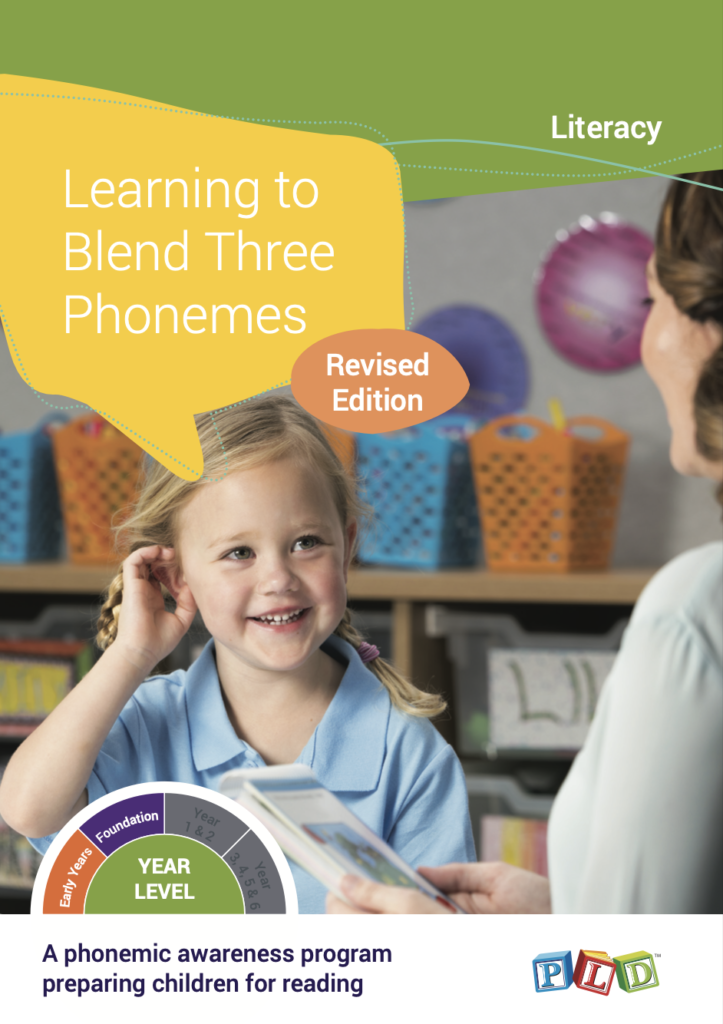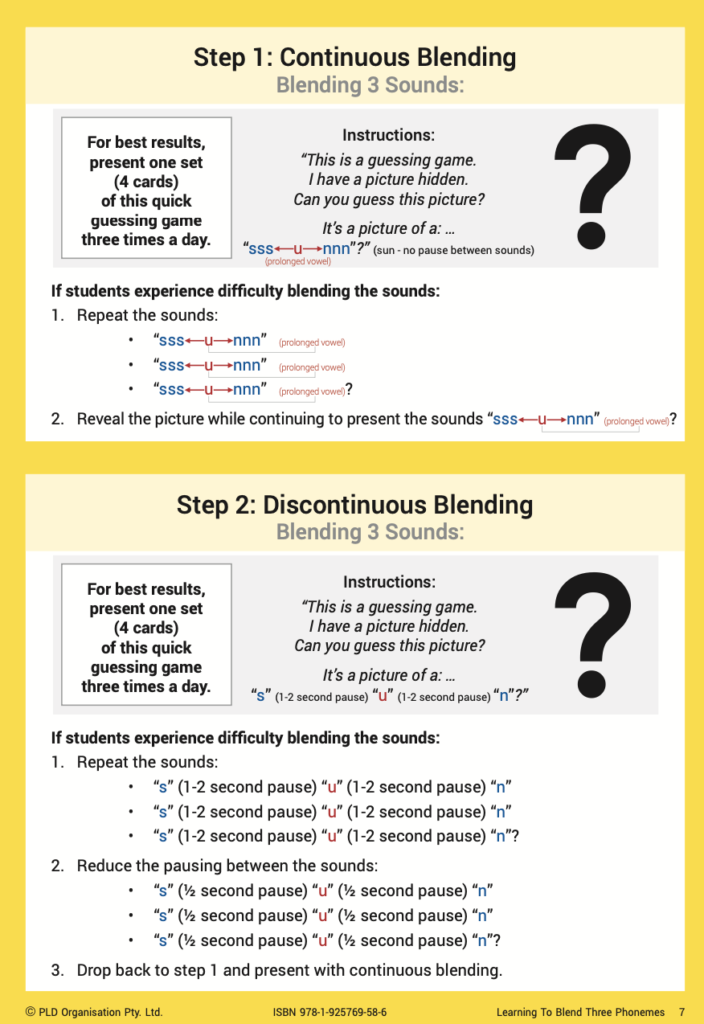What is Blending and Why is it a Necessary Skill in SSP Programs
The two skills required to decode written words are letter-sound knowledge and blending phonemes (Muter et al., 2004). The skill of blending requires students to understand that spoken words are comprised of a series of individual sounds. For example, the word ‘sun’ is made up of the phonemes or sounds /s/ /u/ /n/. Blending is required when a written word is decoded by saying each sound represented by the letters in a word. The reader must be able to push the sounds together to form a whole word. Both blending and letter-sound knowledge are crucial for early readers as they allow students to read hundreds of words after learning only a few letter-sound correspondences.
“If a child memorises ten words, the child can read only ten words, but if the child learns the sounds of ten letters, the child will be able to read 350 three sound words” (Kozloff, 2002)
However, this can only occur if students are able to blend the sounds together to form whole words. Teachers will have experienced some students in their class who know the letter-sound correspondences but are still unable to read words. For those students reading sounds something like this, the word ‘sat’ is read by the student as “s-a-t..tap?”. In this example, the word was read incorrectly due to an underlying skill deficit in blending.
In systematic synthetic phonics (SSP), the word ‘synthetic’ refers to the process of synthesising or blending the individual sounds together to form a word (Konza, 2014). Research supports the importance of blending sounds, with suggestions that “success or failure in early blending has particularly important ramifications” (Neilson, 2020).
However the way sounds are presented to students either in a continuous (rrrruuunn) or discontinuous (r-u-n) manner have been the subject of recent research investigating which techniques are more effective for early readers.

Continuous phonation is a way of presenting the sounds in the word in a connected manner. This means a word is presented without pauses in an exaggerated way with each sound extended into the next. Sounds that can be extended without distortion work best for this kind of approach. For example, in “mmmmaaat” the sounds /m/ and /a/ can be extended while /t/ sound cannot. Recent research suggests that students are most successful at accurately blending words when they are presented in this manner (Gonzalez-Frey & Ehri, 2021).
Discontinuous phonation is a way of presenting the sounds from a word separately so that each sound is pronounced individually. For example, ‘mat’ is presented as /m/ /a/ /t/, ensuring each sound is not distorted by the following sound. Blending using discontinuous phonation requires students to hold these sounds in their phonological memory and then recognise the word which often sounds different in connected speech due to the co-articulation effect (De Graaff et al., 2009). Students who are able to blend, identify, and manipulate separate sounds within words demonstrate strong phonemic awareness abilities. Superior phonemic awareness skills are considered a predictor of later reading success (Hulme et al., 2012).

Which Approach Produces Superior Results for Early Decoding?
There is only limited research comparing discontinuous and continuous phonation to facilitate blending skills necessary for early reading. Therefore, it is important to consider what is working well for your students. In PLD’s approach students begin learning to orally blend words presented in a continuous manner and progress to blending words together from discontinuous sounds (as presented in Learning to Blend Three Phonemes). In our experience students generally pause between each letter or letter combination when they are decoding words and therefore need to develop the skill of holding separate sounds in their phonological memory to blend words accurately.
How to Support Students Struggling With Blending Skills?
It is likely that there will be a number of students at the beginning of Prep/Foundation who struggle to blend three sounds together accurately. PLD’s Term 1 Prep/Foundation teaching sequence emphasises blending and segmenting skills to ensure all students are ready to read and spell words. If students are presenting with blending skills below 40% accuracy on PLD’s Pre-reading Screen (found in the Foundation Screening and Tracking Manual), further investigation into their current blending skill level is necessary.
Most students should accurately identify the word when continuous phonation is used, however if there are still difficulties blending sounds together then attempting less challenging blending tasks may be beneficial. For example, students are usually easily able to blend onset and rime words (e.g., “m-at”) and compound words (e.g., “hot-dog”).
Once you find where the student is successfully blending the sounds together, complete short but frequent sessions presenting material at that level, gradually increasing the difficulty as their accuracy improves.
The following PLD resources can be used to facilitate the practice sessions required to improve students’ blending skills:
Reference List:
- de Graff, S., Bosman, A. M. T., Hasselman, F., & Verhoeven, L. (2009). Benefits of systematic phonics instruction. Journal of Research in Reading, 13(4), 318–333.
- Gonzalez-Frey, S. M., & Ehri, L. C. (2021). Connected phonation is more effective than segmented phonation for teaching beginning readers to decode unfamiliar words. Scientific Studies of Reading, 25(3), 272-285.
- Hulme, C., Bowyer-Crane, C., Carroll, J., Duff, F. J., & Snowling, M. J. (2012). The causal role of phoneme awareness and letter-sound knowledge in learning to read: Combining intervention studies with mediation analyses. Psychological Science, 23, 572–577.
- Konza, D. (2014). Teaching reading: Why the “Fab Five” should be the “Big Six”. Australian Journal of Teacher Education, 39(12), 153–169.
- Kozloff, M. (2002, September 12). A whole language catalogue of the grotesque [Blog post]. Retrieved from http://people.uncw.edu/kozloffm/wlquotes.html
- Muter, V., Hulme, C., Snowling, M. J., & Stevenson, J. (2004). Phonemes, rimes, vocabulary, and grammatical skills as foundations of early reading development: Evidence from a longitudinal study. Developmental Psychology, 40, 663–81.
- National Reading Panel (NRP). (2000). Report of the National Reading Panel: Reports of the subgroups. Washington, DC: National Institute of Child Health and Human Development Clearing House.
- Neilson, R. (2020). The Blending Enigma: What is Best Practice for Teaching Sounding Out and Blending? LDA Bulletin, 52(1), 35-37.



 print
print


